
FunClip
Open-source, accurate and easy-to-use video speech recognition & clipping tool, LLM based AI clipping intergrated.
Stars: 3064
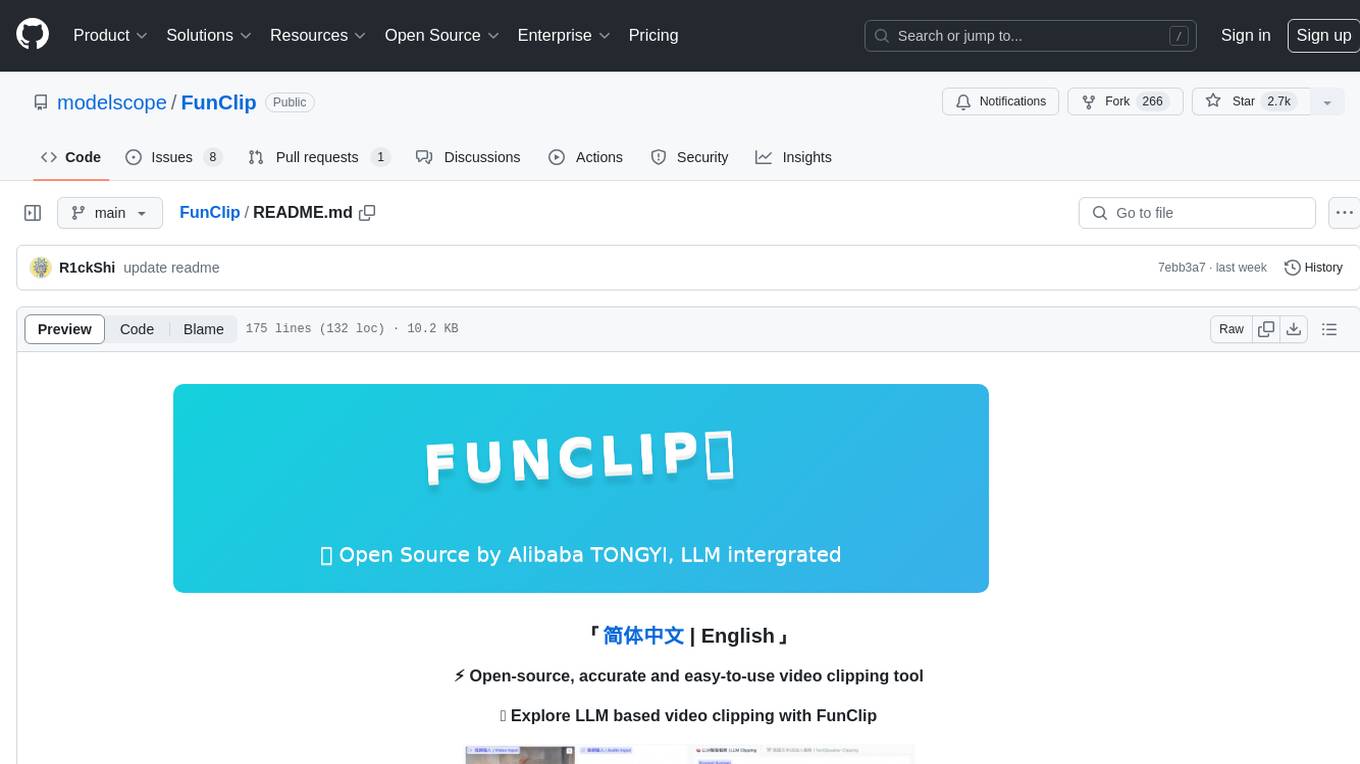
FunClip is an open-source, locally deployed automated video clipping tool that leverages Alibaba TONGYI speech lab's FunASR Paraformer series models for speech recognition on videos. Users can select text segments or speakers from recognition results to obtain corresponding video clips. It integrates industrial-grade models for accurate predictions and offers hotword customization and speaker recognition features. The tool is user-friendly with Gradio interaction, supporting multi-segment clipping and providing full video and target segment subtitles. FunClip is suitable for users looking to automate video clipping tasks with advanced AI capabilities.
README:
「简体中文 | English」
⚡ Open-source, accurate and easy-to-use video clipping tool
🧠 Explore LLM based video clipping with FunClip
What's New | On Going | Install | Usage | Community
FunClip is a fully open-source, locally deployed automated video clipping tool. It leverages Alibaba TONGYI speech lab's open-source FunASR Paraformer series models to perform speech recognition on videos. Then, users can freely choose text segments or speakers from the recognition results and click the clip button to obtain the video clip corresponding to the selected segments (Quick Experience Modelscope⭐ HuggingFace🤗).
- 🔥Try AI clipping using LLM in FunClip now.
- FunClip integrates Alibaba's open-source industrial-grade model Paraformer-Large, which is one of the best-performing open-source Chinese ASR models available, with over 13 million downloads on Modelscope. It can also accurately predict timestamps in an integrated manner.
- FunClip incorporates the hotword customization feature of SeACo-Paraformer, allowing users to specify certain entity words, names, etc., as hotwords during the ASR process to enhance recognition results.
- FunClip integrates the CAM++ speaker recognition model, enabling users to use the auto-recognized speaker ID as the target for trimming, to clip segments from a specific speaker.
- The functionalities are realized through Gradio interaction, offering simple installation and ease of use. It can also be deployed on a server and accessed via a browser.
- FunClip supports multi-segment free clipping and automatically returns full video SRT subtitles and target segment SRT subtitles, offering a simple and convenient user experience.
- 2024/06/12 FunClip supports recognize and clip English audio files now. Run
python funclip/launch.py -l ento try. - 🔥2024/05/13 FunClip v2.0.0 now supports smart clipping with large language models, integrating models from the qwen series, GPT series, etc., providing default prompts. You can also explore and share tips for setting prompts, the usage is as follows:
- After the recognition, select the name of the large model and configure your own apikey;
- Click on the 'LLM Inference' button, and FunClip will automatically combine two prompts with the video's srt subtitles;
- Click on the 'AI Clip' button, and based on the output results of the large language model from the previous step, FunClip will extract the timestamps for clipping;
- You can try changing the prompt to leverage the capabilities of the large language models to get the results you want;
- 2024/05/09 FunClip updated to v1.1.0, including the following updates and fixes:
- Support configuration of output file directory, saving ASR intermediate results and video clipping intermediate files;
- UI upgrade (see guide picture below), video and audio cropping function are on the same page now, button position adjustment;
- Fixed a bug introduced due to FunASR interface upgrade, which has caused some serious clipping errors;
- Support configuring different start and end time offsets for each paragraph;
- Code update, etc;
- 2024/03/06 Fix bugs in using FunClip with command line.
- 2024/02/28 FunASR is updated to 1.0 version, use FunASR1.0 and SeACo-Paraformer to conduct ASR with hotword customization.
- 2023/10/17 Fix bugs in multiple periods chosen, used to return video with wrong length.
- 2023/10/10 FunClipper now supports recognizing with speaker diarization ability, choose 'yes' button in 'Recognize Speakers' and you will get recognition results with speaker id for each sentence. And then you can clip out the periods of one or some speakers (e.g. 'spk0' or 'spk0#spk3') using FunClipper.
- [x] FunClip will support Whisper model for English users, coming soon (ASR using Whisper with timestamp requires massive GPU memory, we support timestamp prediction for vanilla Paraformer in FunASR to achieving this).
- [x] FunClip will further explore the abilities of large langage model based AI clipping, welcome to discuss about prompt setting and clipping, etc.
- [ ] Reverse periods choosing while clipping.
- [ ] Removing silence periods.
FunClip basic functions rely on a python environment only.
# clone funclip repo
git clone https://github.com/alibaba-damo-academy/FunClip.git
cd FunClip
# install Python requirments
pip install -r ./requirements.txtIf you want to clip video file with embedded subtitles
- ffmpeg and imagemagick is required
- On Ubuntu
apt-get -y update && apt-get -y install ffmpeg imagemagick
sed -i 's/none/read,write/g' /etc/ImageMagick-6/policy.xml- On MacOS
brew install imagemagick
sed -i 's/none/read,write/g' /usr/local/Cellar/imagemagick/7.1.1-8_1/etc/ImageMagick-7/policy.xml - On Windows
Download and install imagemagick https://imagemagick.org/script/download.php#windows
Find your python install path and change the IMAGEMAGICK_BINARY to your imagemagick install path in file site-packages\moviepy\config_defaults.py
- Download font file to funclip/font
wget https://isv-data.oss-cn-hangzhou.aliyuncs.com/ics/MaaS/ClipVideo/STHeitiMedium.ttc -O font/STHeitiMedium.ttcYou can establish your own FunClip service which is same as Modelscope Space as follow:
python funclip/launch.py
# '-l en' for English audio recognize
# '-p xxx' for setting port number
# '-s True' for establishing service for public accessingthen visit localhost:7860 you will get a Gradio service like below and you can use FunClip following the steps:
- Step1: Upload your video file (or try the example videos below)
- Step2: Copy the text segments you need to 'Text to Clip'
- Step3: Adjust subtitle settings (if needed)
- Step4: Click 'Clip' or 'Clip and Generate Subtitles'
Follow the guide below to explore LLM based clipping:
FunClip supports you to recognize and clip with commands:
# step1: Recognize
python funclip/videoclipper.py --stage 1 \
--file examples/2022云栖大会_片段.mp4 \
--output_dir ./output
# now you can find recognition results and entire SRT file in ./output/
# step2: Clip
python funclip/videoclipper.py --stage 2 \
--file examples/2022云栖大会_片段.mp4 \
--output_dir ./output \
--dest_text '我们把它跟乡村振兴去结合起来,利用我们的设计的能力' \
--start_ost 0 \
--end_ost 100 \
--output_file './output/res.mp4'FunClip is firstly open-sourced bu FunASR team, any useful PR is welcomed.
You can also scan the following DingTalk group or WeChat group QR code to join the community group for communication.
| DingTalk group | WeChat group |
|---|---|
 |
FunASR hopes to build a bridge between academic research and industrial applications on speech recognition. By supporting the training & finetuning of the industrial-grade speech recognition model released on ModelScope, researchers and developers can conduct research and production of speech recognition models more conveniently, and promote the development of speech recognition ecology. ASR for Fun!
For Tasks:
Click tags to check more tools for each tasksFor Jobs:
Alternative AI tools for FunClip
Similar Open Source Tools

FunClip
FunClip is an open-source, locally deployed automated video clipping tool that leverages Alibaba TONGYI speech lab's FunASR Paraformer series models for speech recognition on videos. Users can select text segments or speakers from recognition results to obtain corresponding video clips. It integrates industrial-grade models for accurate predictions and offers hotword customization and speaker recognition features. The tool is user-friendly with Gradio interaction, supporting multi-segment clipping and providing full video and target segment subtitles. FunClip is suitable for users looking to automate video clipping tasks with advanced AI capabilities.
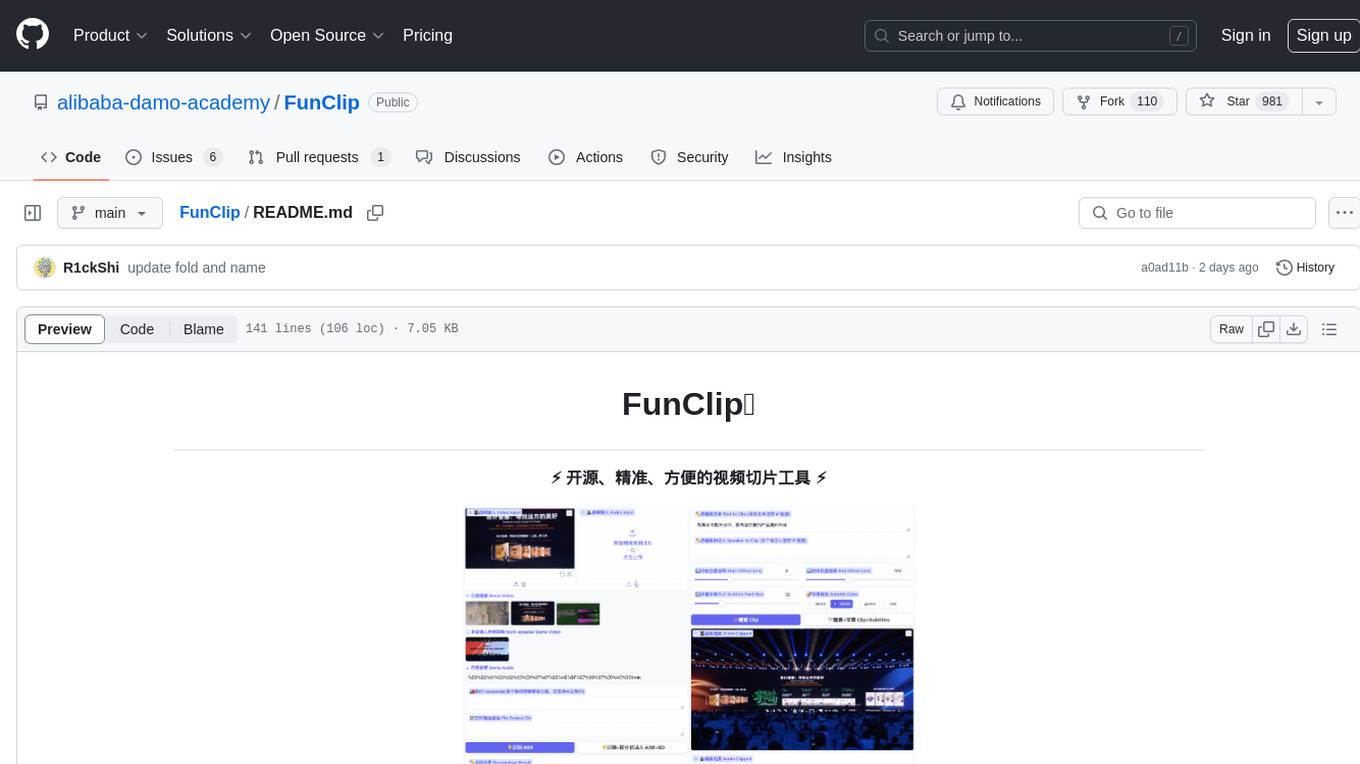
FunClip
FunClip is an open-source, locally deployable automated video editing tool that utilizes the FunASR Paraformer series models from Alibaba DAMO Academy for speech recognition in videos. Users can select text segments or speakers from the recognition results and click the clip button to obtain the corresponding video segments. FunClip integrates advanced features such as the Paraformer-Large model for accurate Chinese ASR, SeACo-Paraformer for customized hotword recognition, CAM++ speaker recognition model, Gradio interactive interface for easy usage, support for multiple free edits with automatic SRT subtitles generation, and segment-specific SRT subtitles.
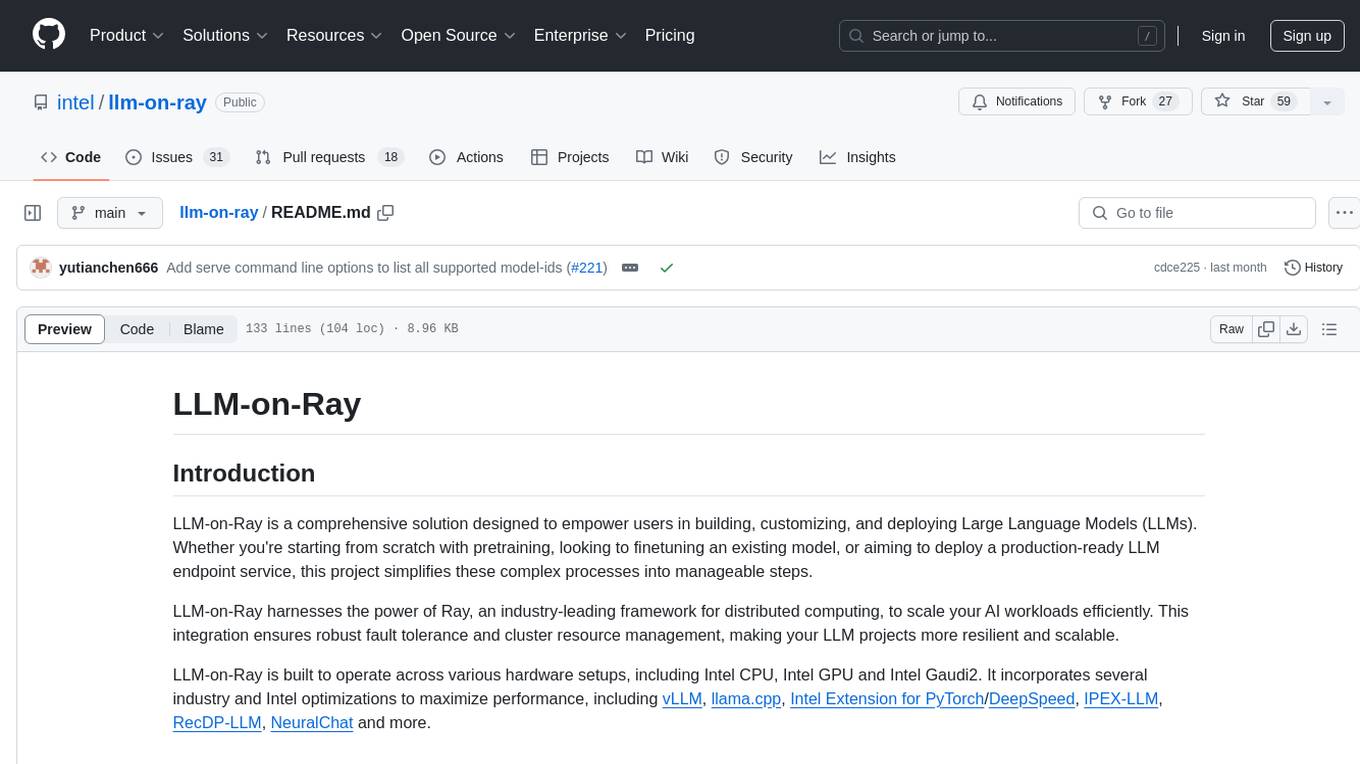
llm-on-ray
LLM-on-Ray is a comprehensive solution for building, customizing, and deploying Large Language Models (LLMs). It simplifies complex processes into manageable steps by leveraging the power of Ray for distributed computing. The tool supports pretraining, finetuning, and serving LLMs across various hardware setups, incorporating industry and Intel optimizations for performance. It offers modular workflows with intuitive configurations, robust fault tolerance, and scalability. Additionally, it provides an Interactive Web UI for enhanced usability, including a chatbot application for testing and refining models.
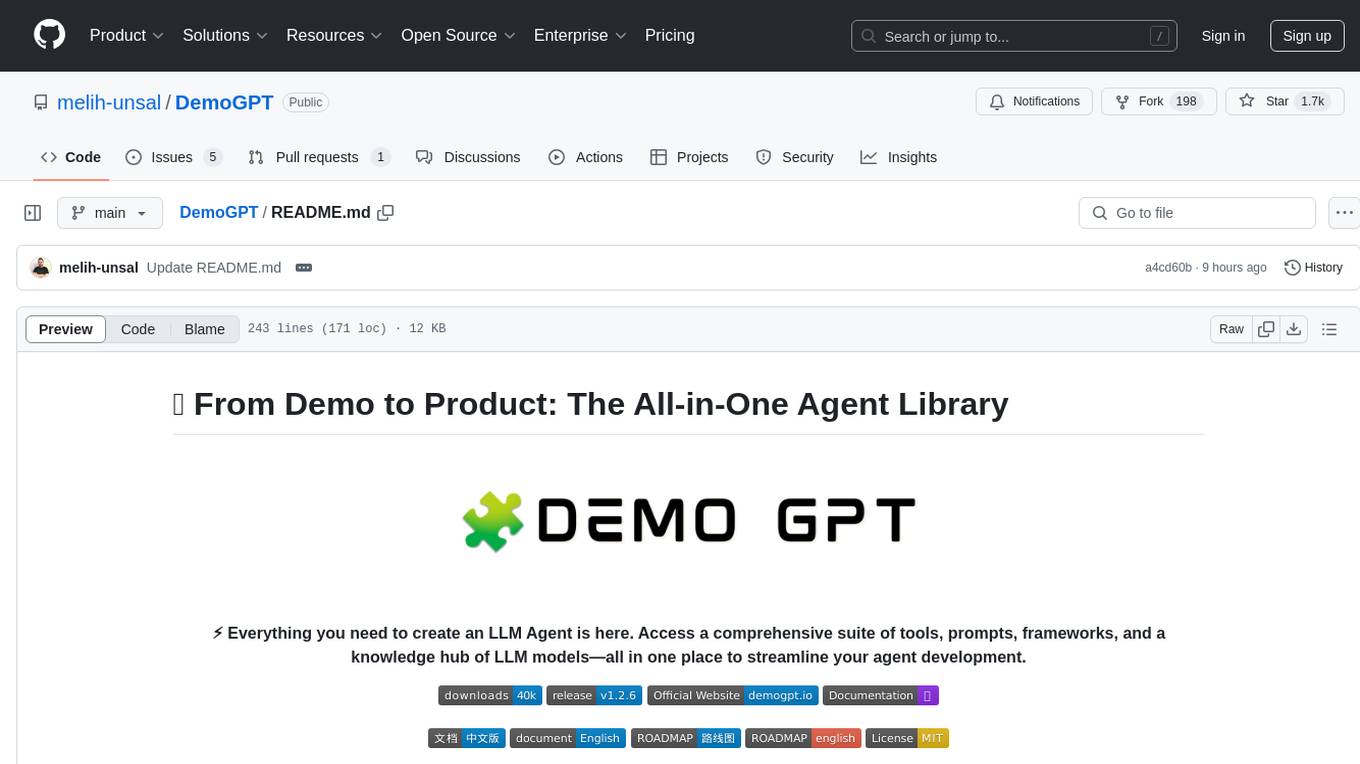
DemoGPT
DemoGPT is an all-in-one agent library that provides tools, prompts, frameworks, and LLM models for streamlined agent development. It leverages GPT-3.5-turbo to generate LangChain code, creating interactive Streamlit applications. The tool is designed for creating intelligent, interactive, and inclusive solutions in LLM-based application development. It offers model flexibility, iterative development, and a commitment to user engagement. Future enhancements include integrating Gorilla for autonomous API usage and adding a publicly available database for refining the generation process.

labelbox-python
Labelbox is a data-centric AI platform for enterprises to develop, optimize, and use AI to solve problems and power new products and services. Enterprises use Labelbox to curate data, generate high-quality human feedback data for computer vision and LLMs, evaluate model performance, and automate tasks by combining AI and human-centric workflows. The academic & research community uses Labelbox for cutting-edge AI research.
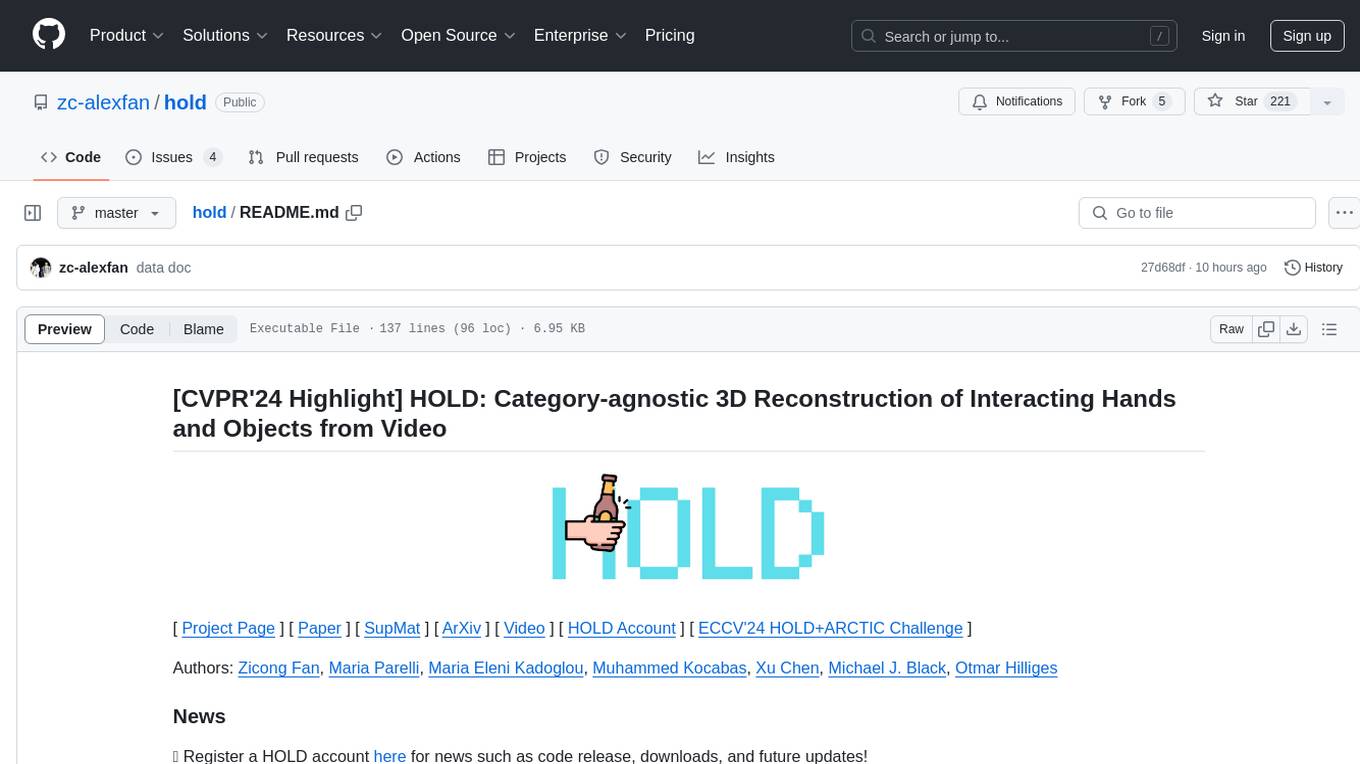
hold
This repository contains the code for HOLD, a method that jointly reconstructs hands and objects from monocular videos without assuming a pre-scanned object template. It can reconstruct 3D geometries of novel objects and hands, enabling template-free bimanual hand-object reconstruction, textureless object interaction with hands, and multiple objects interaction with hands. The repository provides instructions to download in-the-wild videos from HOLD, preprocess and train on custom videos, a volumetric rendering framework, a generalized codebase for single and two hand interaction with objects, a viewer to interact with predictions, and code to evaluate and compare with HOLD in HO3D. The repository also includes documentation for setup, training, evaluation, visualization, preprocessing custom sequences, and using HOLD on ARCTIC.
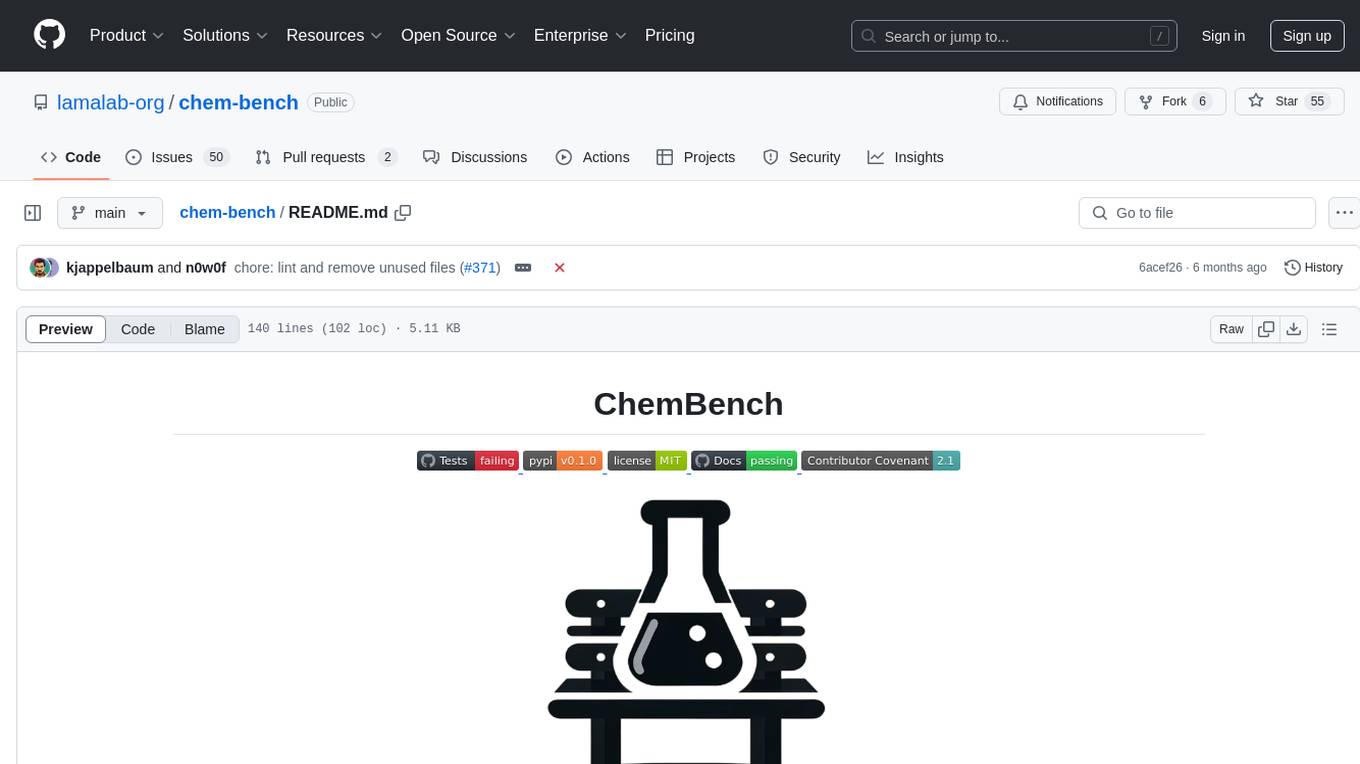
chem-bench
ChemBench is a project aimed at expanding chemistry benchmark tasks in a BIG-bench compatible way, providing a pipeline to benchmark frontier and open models. It allows users to run benchmarking tasks on models with existing presets, offering predefined parameters and processing steps. The library facilitates benchmarking models on the entire suite, addressing challenges such as prompt structure, parsing, and scoring methods. Users can contribute to the project by following the developer notes.
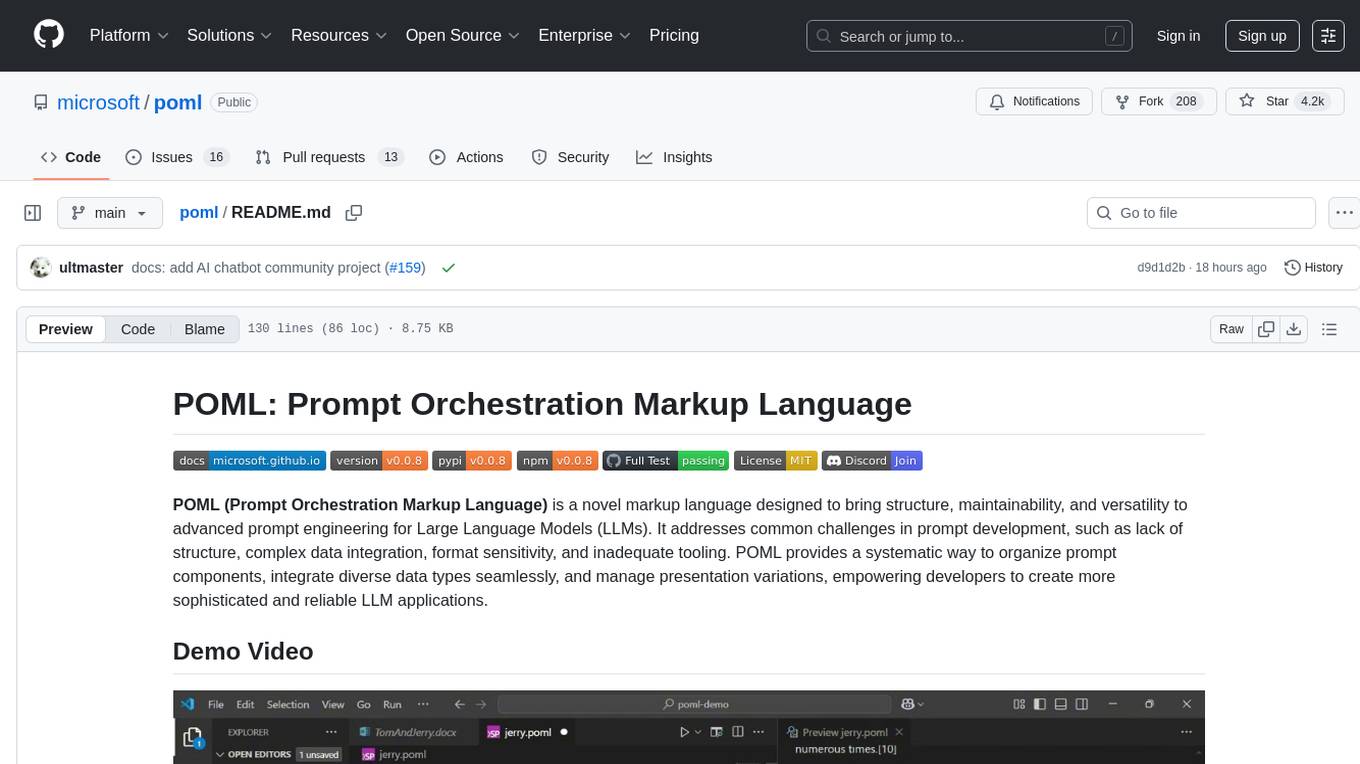
poml
POML (Prompt Orchestration Markup Language) is a novel markup language designed to bring structure, maintainability, and versatility to advanced prompt engineering for Large Language Models (LLMs). It addresses common challenges in prompt development, such as lack of structure, complex data integration, format sensitivity, and inadequate tooling. POML provides a systematic way to organize prompt components, integrate diverse data types seamlessly, and manage presentation variations, empowering developers to create more sophisticated and reliable LLM applications.
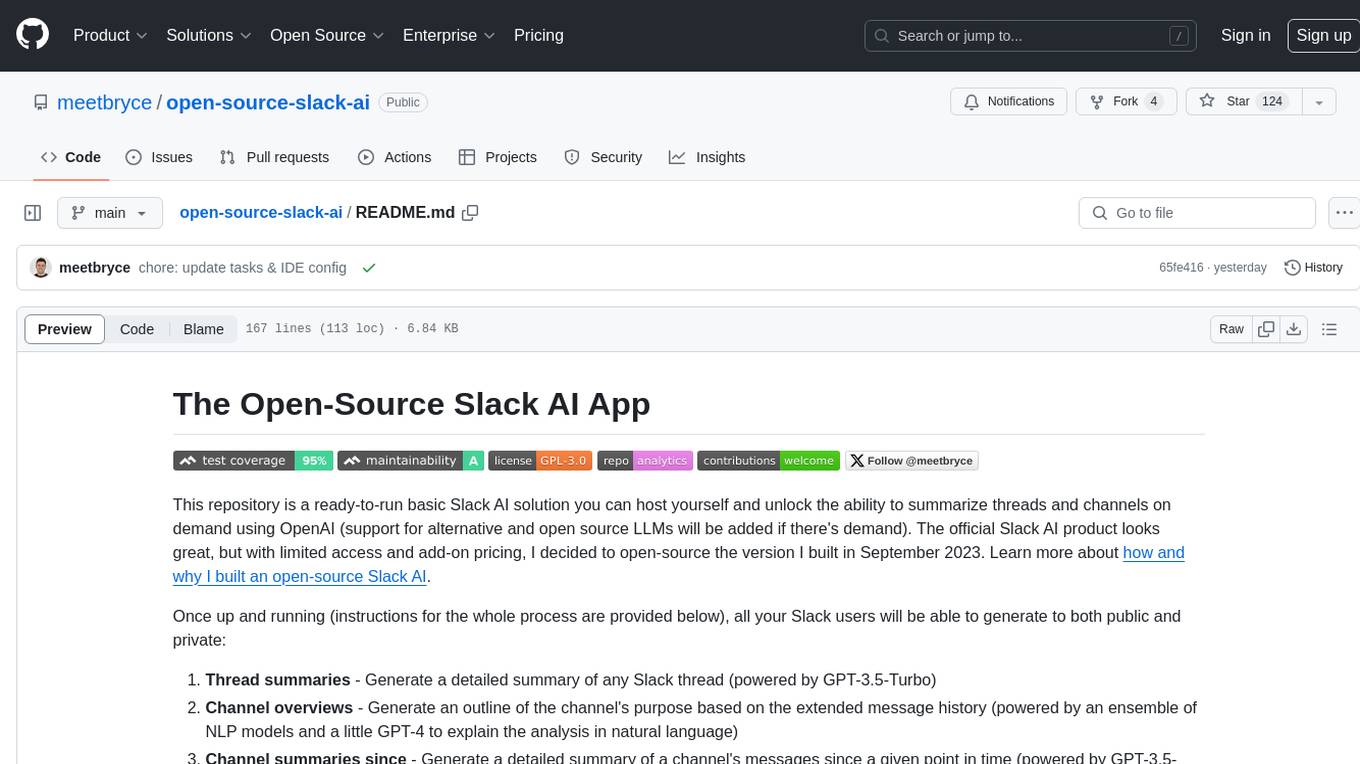
open-source-slack-ai
This repository provides a ready-to-run basic Slack AI solution that allows users to summarize threads and channels using OpenAI. Users can generate thread summaries, channel overviews, channel summaries since a specific time, and full channel summaries. The tool is powered by GPT-3.5-Turbo and an ensemble of NLP models. It requires Python 3.8 or higher, an OpenAI API key, Slack App with associated API tokens, Poetry package manager, and ngrok for local development. Users can customize channel and thread summaries, run tests with coverage using pytest, and contribute to the project for future enhancements.
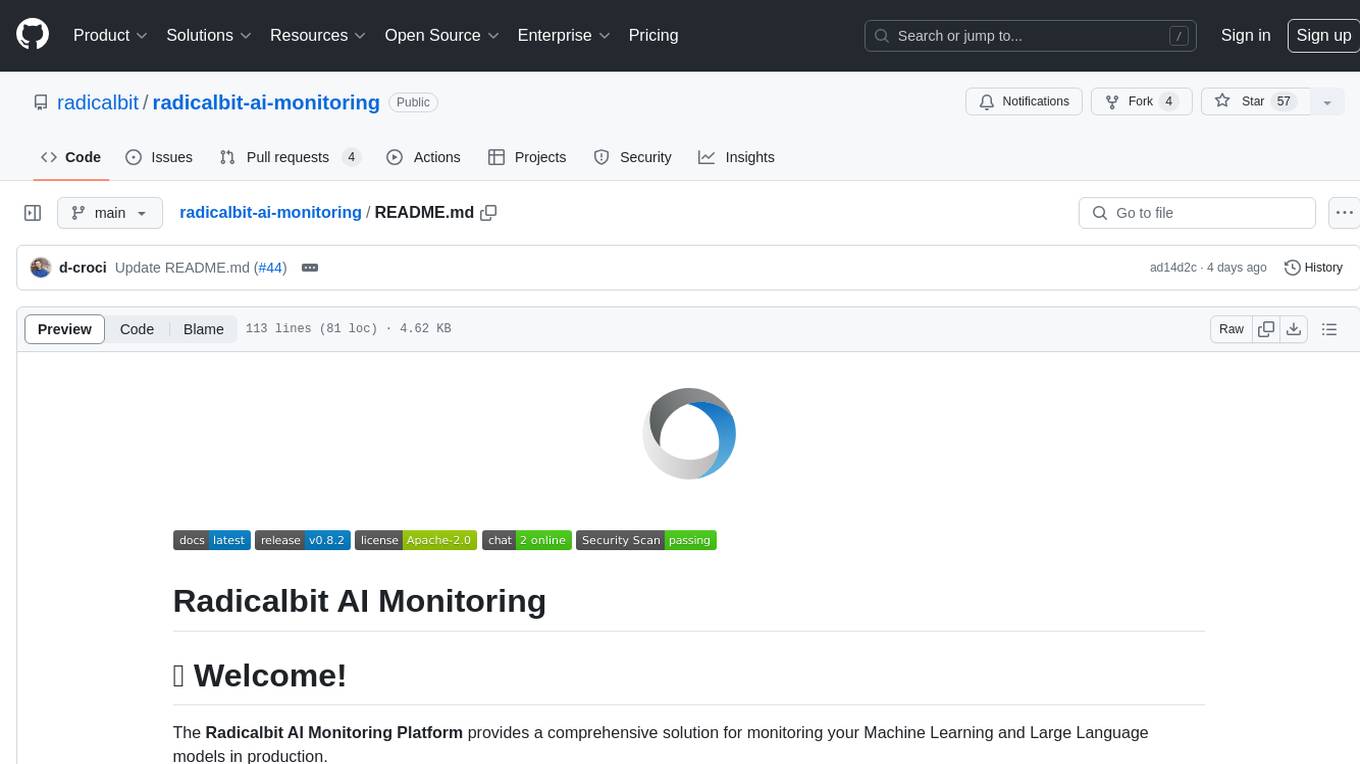
radicalbit-ai-monitoring
The Radicalbit AI Monitoring Platform provides a comprehensive solution for monitoring Machine Learning and Large Language models in production. It helps proactively identify and address potential performance issues by analyzing data quality, model quality, and model drift. The repository contains files and projects for running the platform, including UI, API, SDK, and Spark components. Installation using Docker compose is provided, allowing deployment with a K3s cluster and interaction with a k9s container. The platform documentation includes a step-by-step guide for installation and creating dashboards. Community engagement is encouraged through a Discord server. The roadmap includes adding functionalities for batch and real-time workloads, covering various model types and tasks.

crewAI
CrewAI is a cutting-edge framework designed to orchestrate role-playing autonomous AI agents. By fostering collaborative intelligence, CrewAI empowers agents to work together seamlessly, tackling complex tasks. It enables AI agents to assume roles, share goals, and operate in a cohesive unit, much like a well-oiled crew. Whether you're building a smart assistant platform, an automated customer service ensemble, or a multi-agent research team, CrewAI provides the backbone for sophisticated multi-agent interactions. With features like role-based agent design, autonomous inter-agent delegation, flexible task management, and support for various LLMs, CrewAI offers a dynamic and adaptable solution for both development and production workflows.
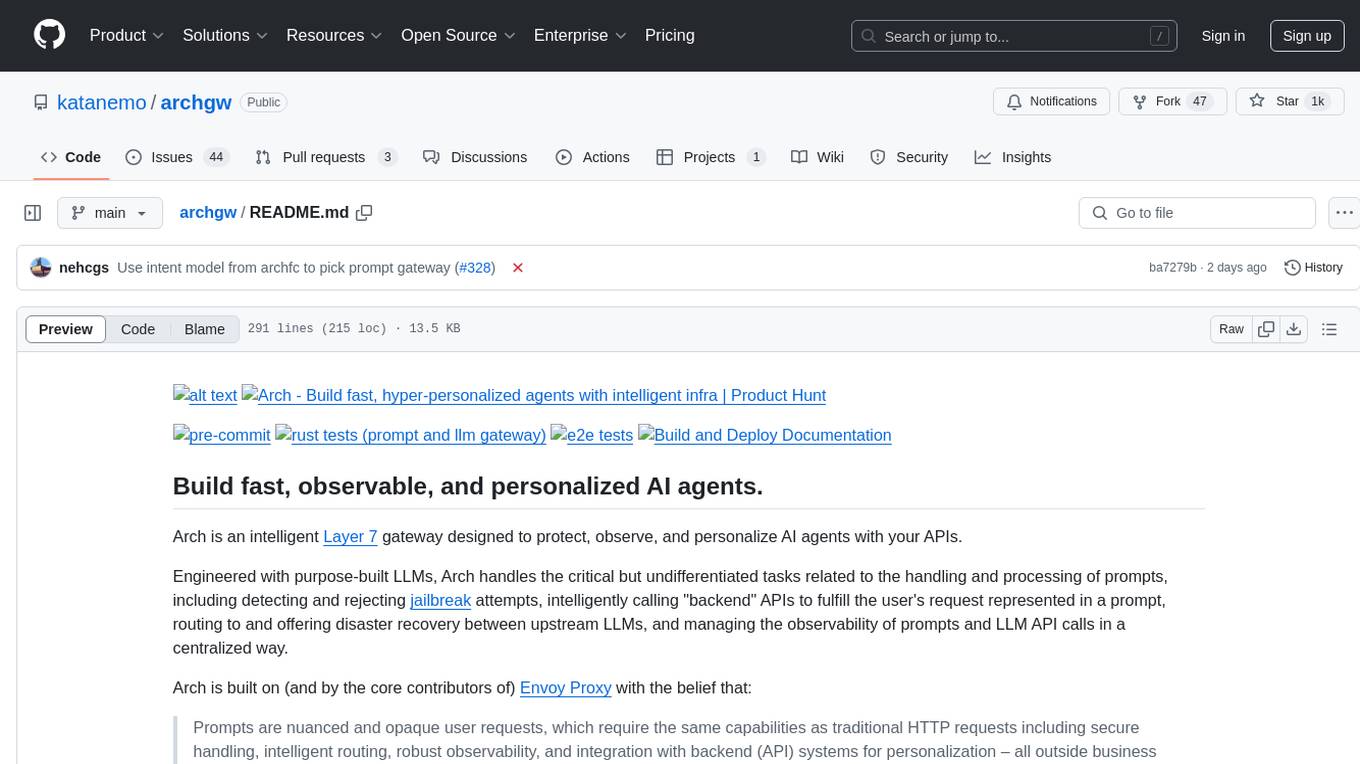
archgw
Arch is an intelligent Layer 7 gateway designed to protect, observe, and personalize AI agents with APIs. It handles tasks related to prompts, including detecting jailbreak attempts, calling backend APIs, routing between LLMs, and managing observability. Built on Envoy Proxy, it offers features like function calling, prompt guardrails, traffic management, and observability. Users can build fast, observable, and personalized AI agents using Arch to improve speed, security, and personalization of GenAI apps.
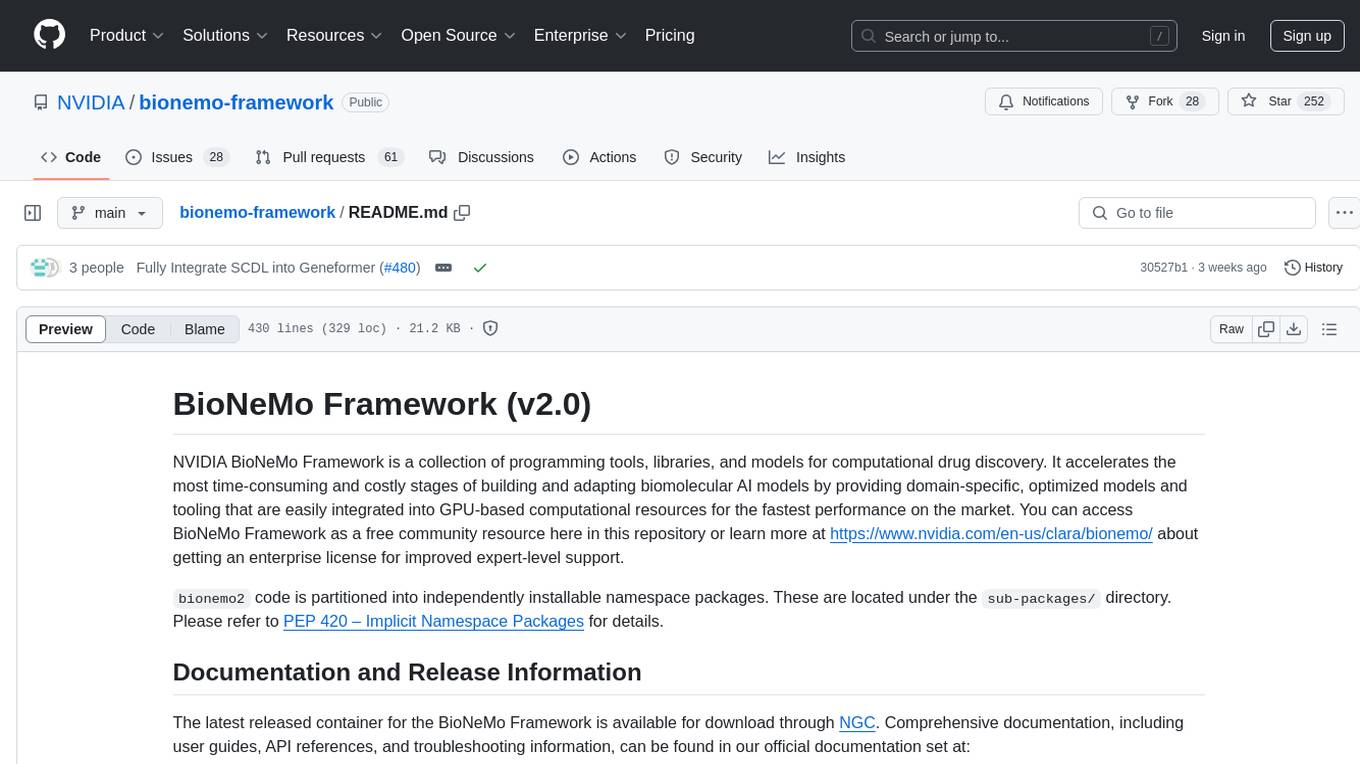
bionemo-framework
NVIDIA BioNeMo Framework is a collection of programming tools, libraries, and models for computational drug discovery. It accelerates building and adapting biomolecular AI models by providing domain-specific, optimized models and tooling for GPU-based computational resources. The framework offers comprehensive documentation and support for both community and enterprise users.
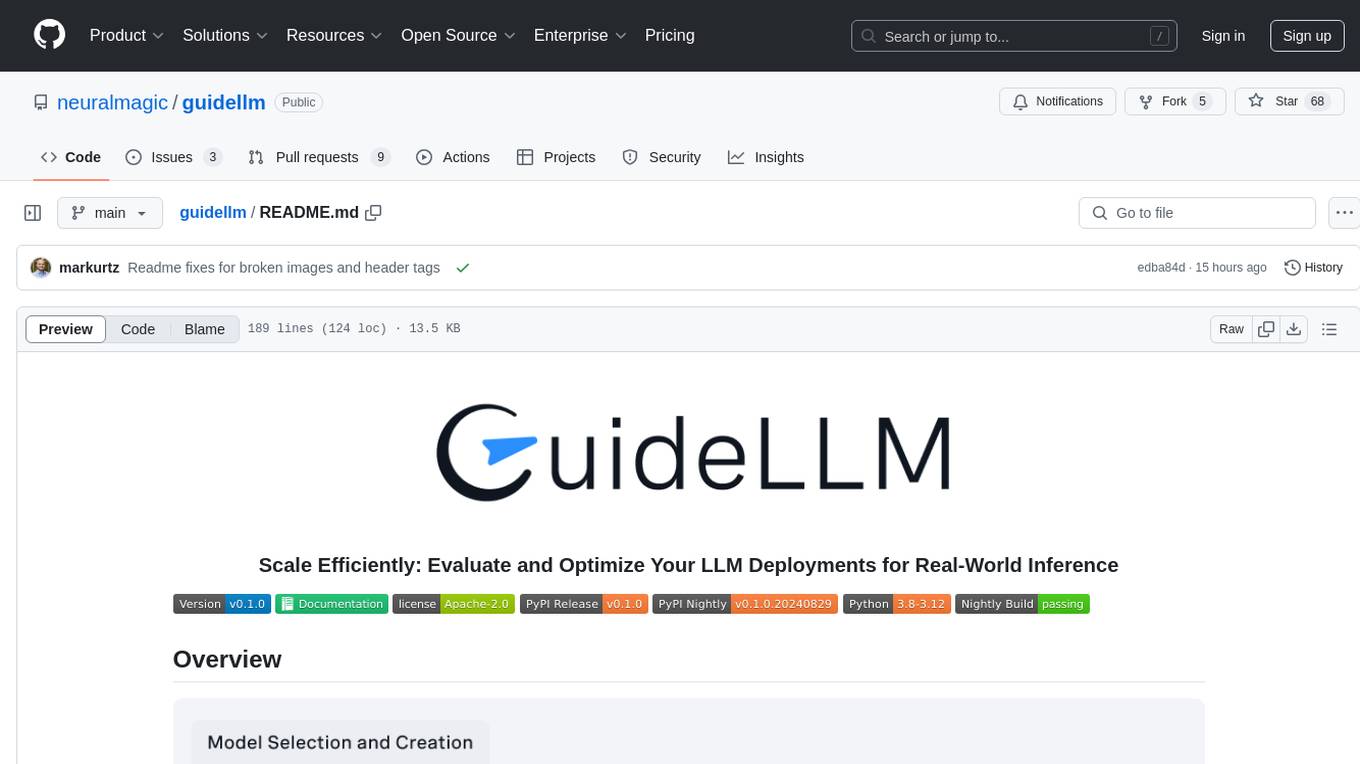
guidellm
GuideLLM is a powerful tool for evaluating and optimizing the deployment of large language models (LLMs). By simulating real-world inference workloads, GuideLLM helps users gauge the performance, resource needs, and cost implications of deploying LLMs on various hardware configurations. This approach ensures efficient, scalable, and cost-effective LLM inference serving while maintaining high service quality. Key features include performance evaluation, resource optimization, cost estimation, and scalability testing.
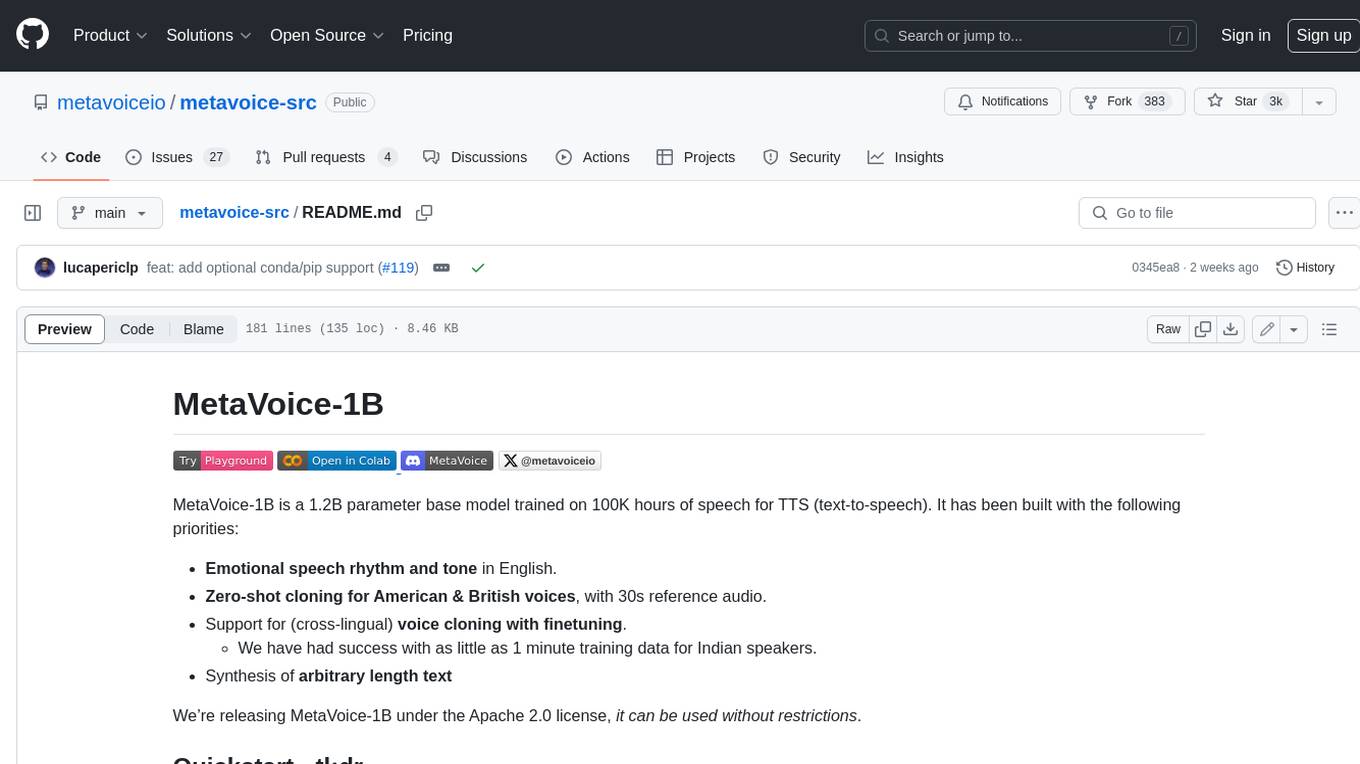
metavoice-src
MetaVoice-1B is a 1.2B parameter base model trained on 100K hours of speech for TTS (text-to-speech). It has been built with the following priorities: * Emotional speech rhythm and tone in English. * Zero-shot cloning for American & British voices, with 30s reference audio. * Support for (cross-lingual) voice cloning with finetuning. * We have had success with as little as 1 minute training data for Indian speakers. * Synthesis of arbitrary length text
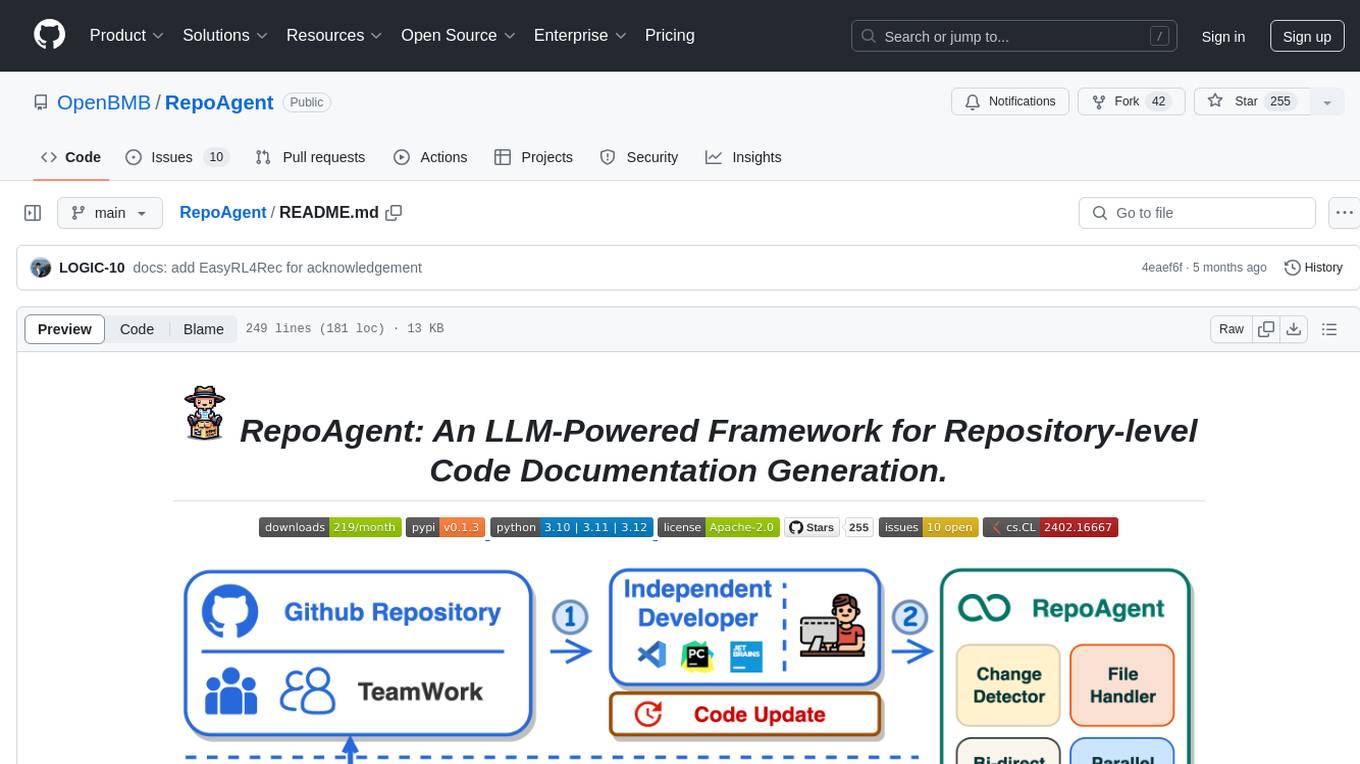
RepoAgent
RepoAgent is an LLM-powered framework designed for repository-level code documentation generation. It automates the process of detecting changes in Git repositories, analyzing code structure through AST, identifying inter-object relationships, replacing Markdown content, and executing multi-threaded operations. The tool aims to assist developers in understanding and maintaining codebases by providing comprehensive documentation, ultimately improving efficiency and saving time.
For similar tasks

FunClip
FunClip is an open-source, locally deployed automated video clipping tool that leverages Alibaba TONGYI speech lab's FunASR Paraformer series models for speech recognition on videos. Users can select text segments or speakers from recognition results to obtain corresponding video clips. It integrates industrial-grade models for accurate predictions and offers hotword customization and speaker recognition features. The tool is user-friendly with Gradio interaction, supporting multi-segment clipping and providing full video and target segment subtitles. FunClip is suitable for users looking to automate video clipping tasks with advanced AI capabilities.

FunClip
FunClip is an open-source, locally deployable automated video editing tool that utilizes the FunASR Paraformer series models from Alibaba DAMO Academy for speech recognition in videos. Users can select text segments or speakers from the recognition results and click the clip button to obtain the corresponding video segments. FunClip integrates advanced features such as the Paraformer-Large model for accurate Chinese ASR, SeACo-Paraformer for customized hotword recognition, CAM++ speaker recognition model, Gradio interactive interface for easy usage, support for multiple free edits with automatic SRT subtitles generation, and segment-specific SRT subtitles.
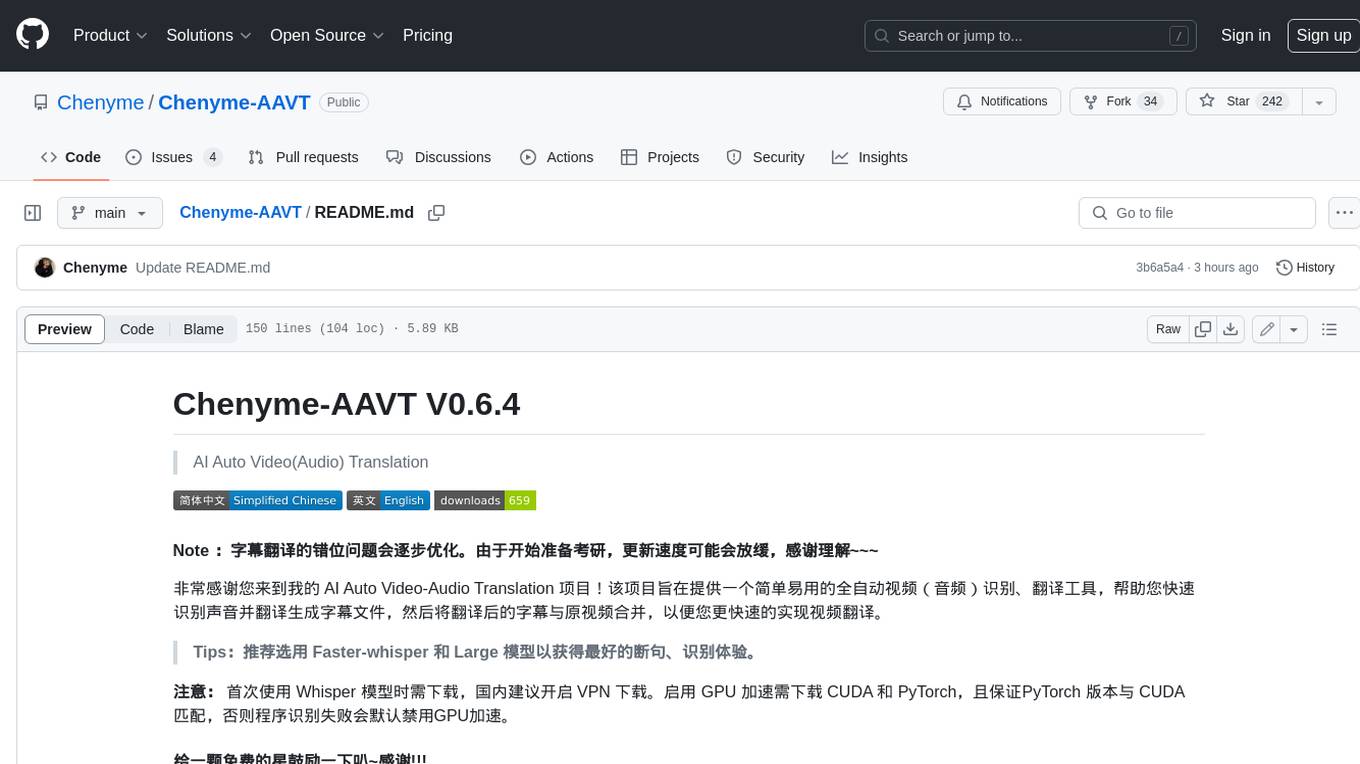
Chenyme-AAVT
Chenyme-AAVT is a user-friendly tool that provides automatic video and audio recognition and translation. It leverages the capabilities of Whisper, a powerful speech recognition model, to accurately identify speech in videos and audios. The recognized speech is then translated using ChatGPT or KIMI, ensuring high-quality translations. With Chenyme-AAVT, you can quickly generate字幕 files and merge them with the original video, making video translation a breeze. The tool supports various languages, allowing you to translate videos and audios into your desired language. Additionally, Chenyme-AAVT offers features such as VAD (Voice Activity Detection) to enhance recognition accuracy, GPU acceleration for faster processing, and support for multiple字幕 formats. Whether you're a content creator, translator, or anyone looking to make video translation more efficient, Chenyme-AAVT is an invaluable tool.
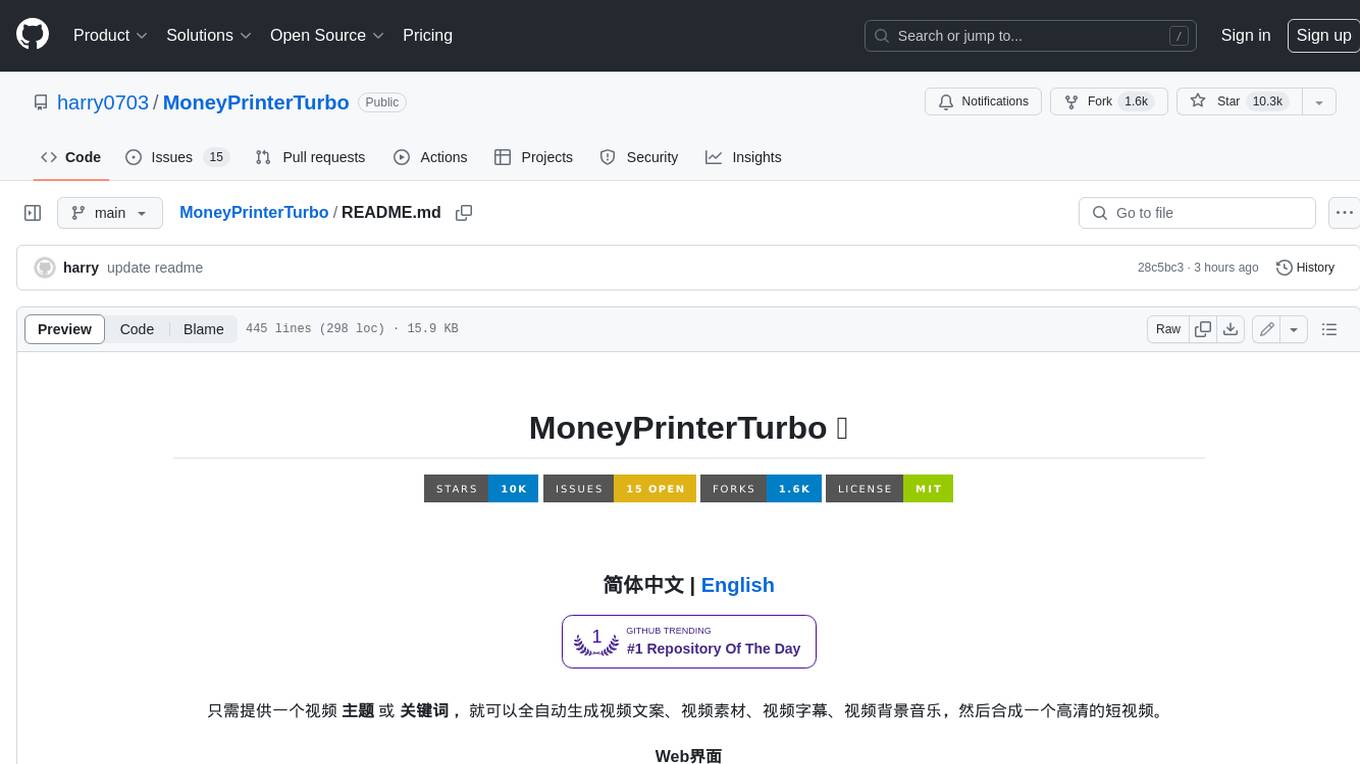
MoneyPrinterTurbo
MoneyPrinterTurbo is a tool that can automatically generate video content based on a provided theme or keyword. It can create video scripts, materials, subtitles, and background music, and then compile them into a high-definition short video. The tool features a web interface and an API interface, supporting AI-generated video scripts, customizable scripts, multiple HD video sizes, batch video generation, customizable video segment duration, multilingual video scripts, multiple voice synthesis options, subtitle generation with font customization, background music selection, access to high-definition and copyright-free video materials, and integration with various AI models like OpenAI, moonshot, Azure, and more. The tool aims to simplify the video creation process and offers future plans to enhance voice synthesis, add video transition effects, provide more video material sources, offer video length options, include free network proxies, enable real-time voice and music previews, support additional voice synthesis services, and facilitate automatic uploads to YouTube platform.
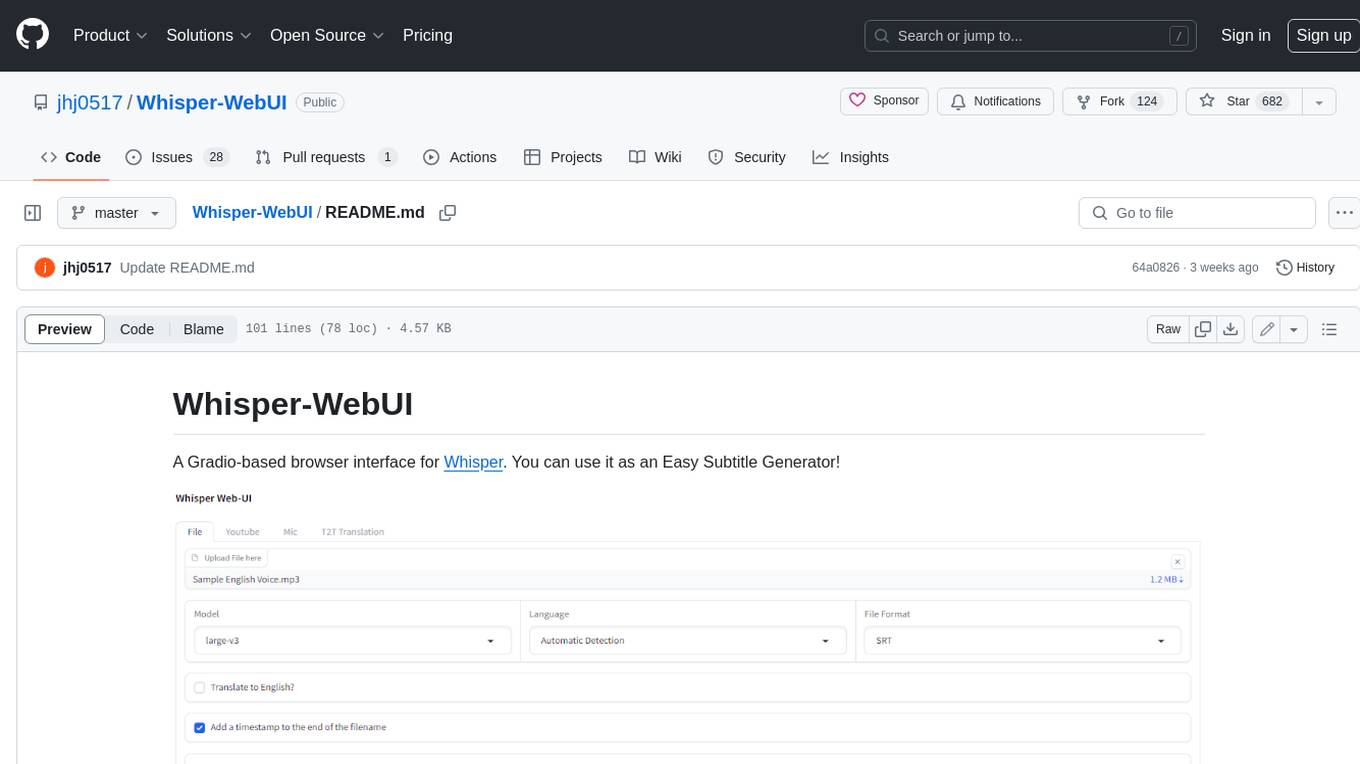
Whisper-WebUI
Whisper-WebUI is a Gradio-based browser interface for Whisper, serving as an Easy Subtitle Generator. It supports generating subtitles from various sources such as files, YouTube, and microphone. The tool also offers speech-to-text and text-to-text translation features, utilizing Facebook NLLB models and DeepL API. Users can translate subtitle files from other languages to English and vice versa. The project integrates faster-whisper for improved VRAM usage and transcription speed, providing efficiency metrics for optimized whisper models. Additionally, users can choose from different Whisper models based on size and language requirements.

openlrc
Open-Lyrics is a Python library that transcribes voice files using faster-whisper and translates/polishes the resulting text into `.lrc` files in the desired language using LLM, e.g. OpenAI-GPT, Anthropic-Claude. It offers well preprocessed audio to reduce hallucination and context-aware translation to improve translation quality. Users can install the library from PyPI or GitHub and follow the installation steps to set up the environment. The tool supports GUI usage and provides Python code examples for transcription and translation tasks. It also includes features like utilizing context and glossary for translation enhancement, pricing information for different models, and a list of todo tasks for future improvements.
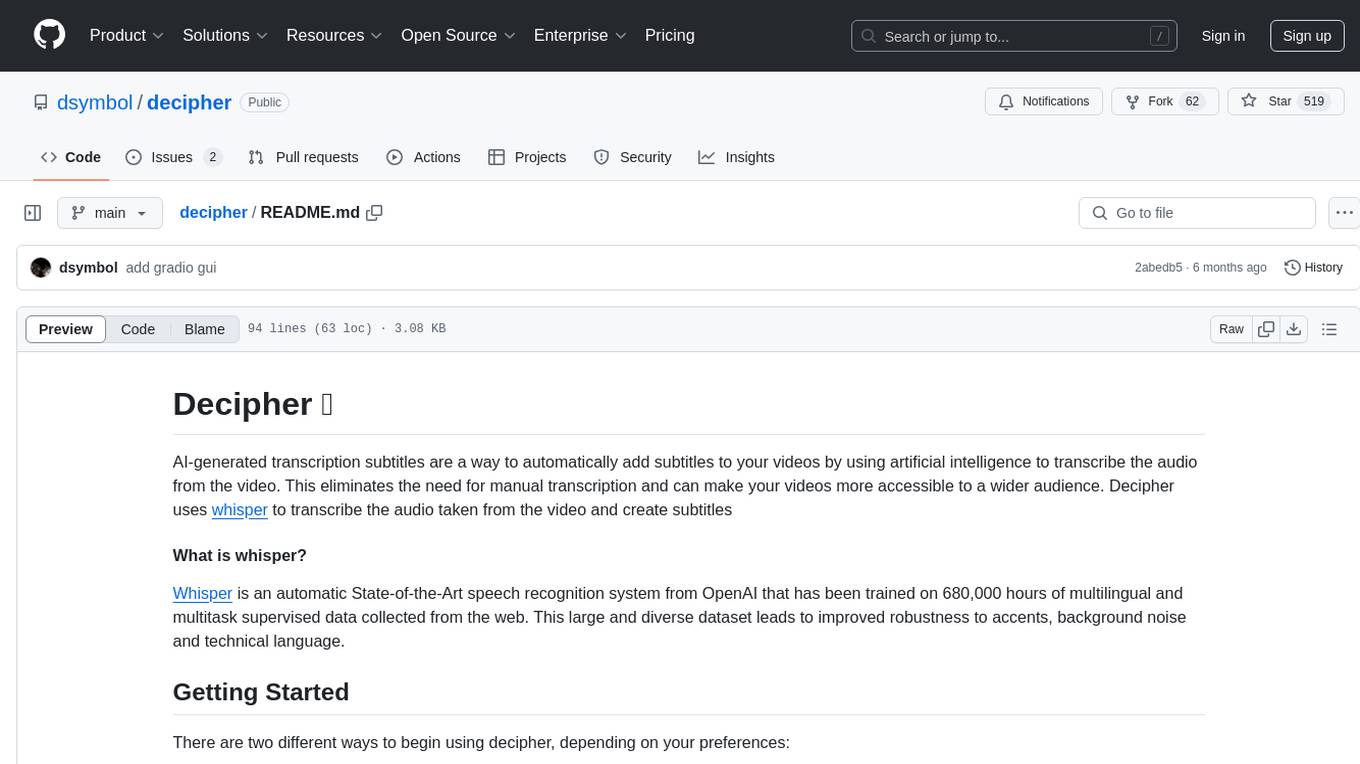
decipher
Decipher is a tool that utilizes AI-generated transcription subtitles to automatically add subtitles to videos. It eliminates the need for manual transcription, making videos more accessible. The tool uses OpenAI's Whisper, a State-of-the-Art speech recognition system trained on a large dataset for improved robustness to accents, background noise, and technical language.
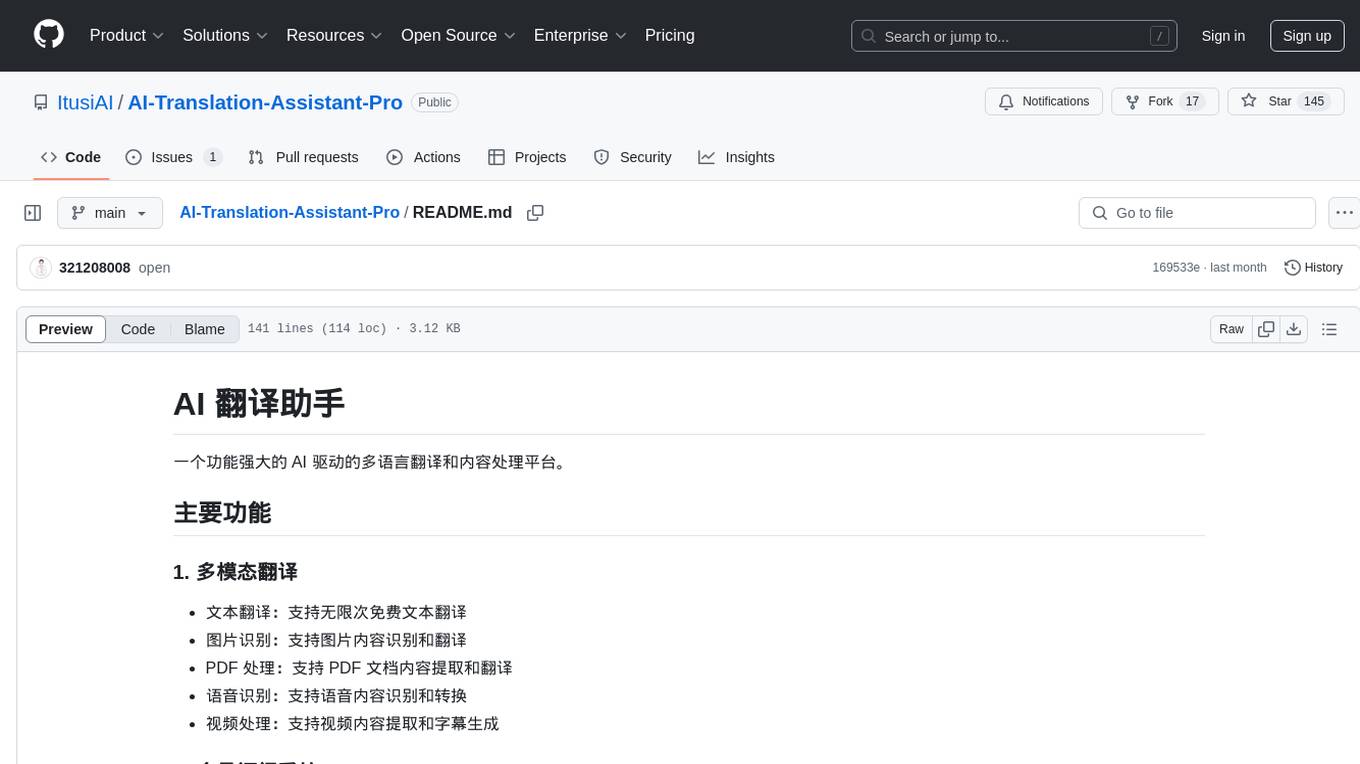
AI-Translation-Assistant-Pro
AI Translation Assistant Pro is a powerful AI-driven platform for multilingual translation and content processing. It offers features such as text translation, image recognition, PDF processing, speech recognition, and video processing. The platform includes a subscription system with different membership levels, user management functionalities, quota management, and real-time usage statistics. It utilizes technologies like Next.js, React, TypeScript for the frontend, Node.js, PostgreSQL for the backend, NextAuth.js for authentication, Stripe for payments, and integrates with cloud services like Aliyun OSS and Tencent Cloud for AI services.
For similar jobs

sweep
Sweep is an AI junior developer that turns bugs and feature requests into code changes. It automatically handles developer experience improvements like adding type hints and improving test coverage.

teams-ai
The Teams AI Library is a software development kit (SDK) that helps developers create bots that can interact with Teams and Microsoft 365 applications. It is built on top of the Bot Framework SDK and simplifies the process of developing bots that interact with Teams' artificial intelligence capabilities. The SDK is available for JavaScript/TypeScript, .NET, and Python.

ai-guide
This guide is dedicated to Large Language Models (LLMs) that you can run on your home computer. It assumes your PC is a lower-end, non-gaming setup.

classifai
Supercharge WordPress Content Workflows and Engagement with Artificial Intelligence. Tap into leading cloud-based services like OpenAI, Microsoft Azure AI, Google Gemini and IBM Watson to augment your WordPress-powered websites. Publish content faster while improving SEO performance and increasing audience engagement. ClassifAI integrates Artificial Intelligence and Machine Learning technologies to lighten your workload and eliminate tedious tasks, giving you more time to create original content that matters.

chatbot-ui
Chatbot UI is an open-source AI chat app that allows users to create and deploy their own AI chatbots. It is easy to use and can be customized to fit any need. Chatbot UI is perfect for businesses, developers, and anyone who wants to create a chatbot.

BricksLLM
BricksLLM is a cloud native AI gateway written in Go. Currently, it provides native support for OpenAI, Anthropic, Azure OpenAI and vLLM. BricksLLM aims to provide enterprise level infrastructure that can power any LLM production use cases. Here are some use cases for BricksLLM: * Set LLM usage limits for users on different pricing tiers * Track LLM usage on a per user and per organization basis * Block or redact requests containing PIIs * Improve LLM reliability with failovers, retries and caching * Distribute API keys with rate limits and cost limits for internal development/production use cases * Distribute API keys with rate limits and cost limits for students

uAgents
uAgents is a Python library developed by Fetch.ai that allows for the creation of autonomous AI agents. These agents can perform various tasks on a schedule or take action on various events. uAgents are easy to create and manage, and they are connected to a fast-growing network of other uAgents. They are also secure, with cryptographically secured messages and wallets.

griptape
Griptape is a modular Python framework for building AI-powered applications that securely connect to your enterprise data and APIs. It offers developers the ability to maintain control and flexibility at every step. Griptape's core components include Structures (Agents, Pipelines, and Workflows), Tasks, Tools, Memory (Conversation Memory, Task Memory, and Meta Memory), Drivers (Prompt and Embedding Drivers, Vector Store Drivers, Image Generation Drivers, Image Query Drivers, SQL Drivers, Web Scraper Drivers, and Conversation Memory Drivers), Engines (Query Engines, Extraction Engines, Summary Engines, Image Generation Engines, and Image Query Engines), and additional components (Rulesets, Loaders, Artifacts, Chunkers, and Tokenizers). Griptape enables developers to create AI-powered applications with ease and efficiency.






